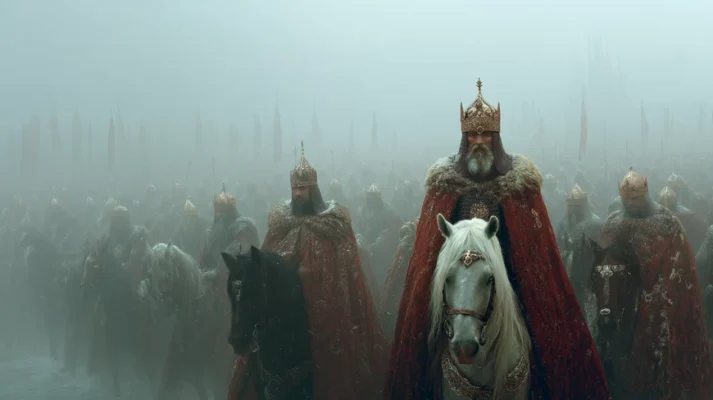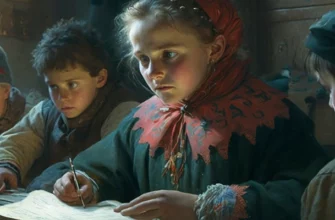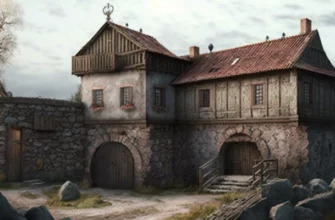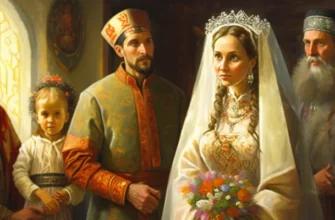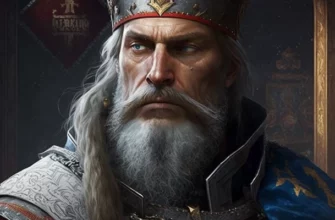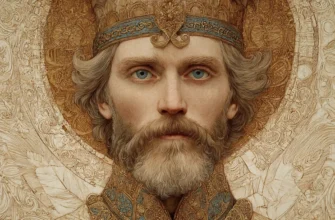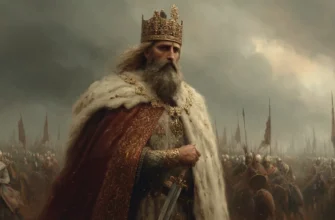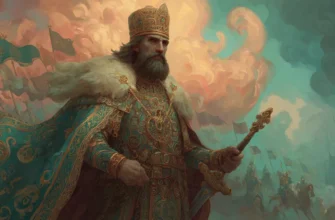Kniaz Igor Rurikovich was the ruler of Kievan Rus, who reigned from the late ninth to the mid-tenth century. He was the son of Rurik and the heir to Oleg the Great. Igor continued the work of his predecessors: he strengthened the state, expanded its influence, and collected tribute from the conquered tribes.
The most famous events of his reign were the campaigns against Byzantium. In 941, Igor launched an unsuccessful attack that resulted in the destruction of his fleet by “Greek fire.” However, already in 944 he conducted a new campaign, which ended in a favorable peace agreement for Rus.
Igor’s domestic policy was based on the traditional system of tribute collection from subordinate tribes. However, an attempt to collect additional tribute from the Drevlyans in 945 caused outrage. As a result of the uprising, Prince Ihor was brutally murdered-he was tied to two bent trees and then released.
After his death, the reign passed to his wife, Olga the Wise, who took brutal revenge on the Drevlyans and carried out important reforms.
The reign of Igor was a transitional stage from a policy of conquest to the strengthening of internal power. His death pointed to the need for changes in state administration, which Olga later implemented.Contents.Origin and accession to the throneForeign policy of Prince IgorMilitary campaigns against ByzantiumThe campaign of 941The campaign of 944Relations with nomadic tribesInternal policy and public administrationOrganization of tribute collection, maintenance of orderThe death of Prince IgorThe role of Olga after his deathConclusionsContents
- Origin and accession to the throne
- Foreign policy of Prince Igor
- Military campaigns against Byzantium
- The campaign of 941
- The campaign of 944
- Relations with nomadic tribes
- Domestic policy and public administration
- Organization of tribute collection and maintenance of order
- The death of Prince Ihor
- Olga’s role after his death
- Conclusions.
Origin and accession to the throne
Kniaz Ihor Rurikovich was the son of the legendary Varangian Rurik, the founder of the princely dynasty in Russia. After Rurik’s death, his relative and military leader Oleh temporarily took over the reigns, ruling as a guardian of the young Igor.
Oleg united the northern and southern lands of Rus, founded Kyiv as the capital, and laid the foundations of statehood. After his death around 912, Igor officially became the prince of Kievan Rus. By the time he ascended the throne, he was already an experienced warrior and ruler.
His reign continued the policy of centralization, strengthening princely power, and maintaining control over dependent tribes. Ihor tried to maintain the unity of the state in the face of growing pressure from both outside and inside.
After the death of Kniaz Oleg in about 912, power in Kievan Rus passed to Igor Rurikovich. By that time, Igor was already an adult and had sufficient military and political experience. The transfer of power took place peacefully, because Igor was the rightful heir, the son of Rurik, whom Oleg only temporarily replaced as guardian.
Ruling Rus for several decades, Oleg strengthened the state and prepared the ground for Igor’s successful reign. This gave Igor a stable and centralized government, but he had to continue to fight to maintain control over the dependent tribes, in particular by collecting tribute (populace).
Ihor’s reign continued the course initiated by Oleg, preserving the unity of the state, expanding its influence, and strengthening princely power.
Foreign policy of Prince Igor
Kniaz Ihor’s foreign policy was aimed at strengthening the position of Kievan Rus among neighboring nations, expanding trade relations, and maintaining control over dependent territories.
The most important events were the campaigns against Byzantium. In 941, Igor led a large naval campaign against Constantinople. However, the Byzantines used “Greek fire” and defeated the Russian fleet. In 944, Igor made a second campaign, which ended in a peace treaty. The new treaty was less favorable than Oleg’s agreement, but it allowed for the resumption of trade relations.
Igor also fought against nomadic tribes, primarily the Pechenegs, who threatened the southern borders of Rus. Ihor’s foreign policy was mainly military, but it also had economic significance, as it ensured control over trade routes, in particular the route “from the Varangians to the Greeks.”
In general, his actions helped to preserve Kyiv’s authority in the region and maintain active foreign trade.
Military campaigns against Byzantium
One of the most important directions of Kniaz Ihor’s foreign policy was his campaigns against Byzantium, a powerful Christian empire with which Rus’ sought to establish profitable trade relations.
The campaign of 941
In 941, Kniaz Igor organized a large-scale naval campaign against Byzantium, one of the most powerful empires of the time. The main goal of the campaign was to force the Byzantine Emperor Constantine VII to renegotiate a trade agreement on more favorable terms for Rus and to provide better conditions for collecting tribute.
Ihor’s fleet consisted of about 1000 ships (drakkars) and thousands of soldiers. Russian troops moved across the Black Sea to the Byzantine coast and began to devastate the coastal lands, destroying cities, looting villages, and damaging trade routes.
The Byzantines, preparing for defense, used their secret weapon, the “Greek fire,” an incendiary mixture that was difficult to extinguish and spread over the surface of the water. This weapon caused a real catastrophe for the Russian fleet: many ships caught fire and sank, and a significant number of troops were killed or forced to retreat.
After the crushing defeat, Ihor withdrew the remnants of his army back to Kyiv. Despite the military failure, the campaign of 941 showed the ambitions of Rus’ as a force seeking to influence important international relations.
The campaign also spurred negotiations that led to a new, more peaceful treaty between Kievan Rus and Byzantium in 944.
The campaign of 944
After the unsuccessful campaign of 941, Prince Ihor did not give up trying to strengthen the position of Kievan Rus in relations with the Byzantine Empire. In 944, he organized a new campaign against Constantinople, but this time he chose a diplomatic and peaceful way to resolve the conflict.
Instead of a large military campaign, Igor sent an embassy with demands to revise the terms of a trade treaty in favor of Rus. The Byzantine Emperor Constantine VII, realizing the importance of peaceful relations with Russia, agreed to negotiate.
As a result, a new treaty was signed that regulated the rights and obligations of both parties. It defined the terms of trade, the procedure for the stay of Russian merchants in Constantinople, and security measures for both sides. This treaty was less favorable for Rus than the previous one, concluded in the time of Oleg, but it helped to stabilize relations and ensure peace.
The campaign of 944 demonstrated that Kievan Rus was not only able to conduct military operations but also used diplomacy to protect its interests. This peaceful step contributed to the development of trade and strengthened the international authority of Prince Igor.
These campaigns demonstrated the strength and ambitions of Kievan Rus, as well as its desire to strengthen economic and political ties with Byzantium. Although Igor did not win in battle, the diplomatic outcome of the second campaign was important for the state.
After the unsuccessful campaign of 941, Prince Ihor began diplomatic negotiations with the Byzantine Empire in 944. The Byzantine Emperor Constantine VII agreed to sign a new peace treaty that regulated trade and political relations between Kievan Rus and Byzantium.
The new treaty clarified the rights of Rus merchants in Constantinople, established the procedure for trade and mutual security guarantees. It also prohibited attacks by Rus’ on Byzantine possessions and established mechanisms for resolving conflicts.
Although this treaty was less favorable than the agreement during the time of Prince Oleg, it allowed for peace and active trade relations. The agreements of 944 were an important step in strengthening diplomatic relations between the two states.
Relations with nomadic tribes
During the reign of Prince Ihor, Kievan Rus faced a constant threat from nomadic tribes, in particular the Pechenegs, who actively raided the southern and eastern borders of the state.
Igor sought to maintain control over the borderlands to ensure the security of trade routes and stability in the state. To do this, he conducted military campaigns against the Pechenegs and entered into temporary alliances with individual tribes.
Relations with the nomads were complex and volatile, ranging from enmity and military clashes to trade contacts and diplomatic agreements. This was typical of interstate relations at the time, when the balance of power was often determined by the military strength and political flexibility of the ruler.
Thus, the struggle and cooperation with nomadic tribes was an important element of Prince Igor’s foreign policy and had a great impact on the stability of Kievan Rus.
During the reign of Prince Ihor, Kievan Rus maintained complicated relations with the Pechenegs, a nomadic tribe that threatened the southern borders of the state. The Pechenegs regularly raided the lands of Rus, forcing the prince to conduct military campaigns to protect the territories and trade routes.
In addition to the Pechenegs, Ihor maintained diplomatic and trade relations with other neighboring peoples, such as the Slavs, Finno-Ugric tribes, and Byzantium and the Khazar states. These contacts were important for the economic development of Rus’ and the exchange of cultural and military knowledge.
Relations with neighbors were dynamic, combining conflicts and alliances. Military threats forced Ihor to react flexibly, to conclude temporary truces or joint defense alliances. Thus, contacts with the Pechenegs and other peoples influenced the security and stability of Kievan Rus during his reign.
Domestic policy and public administration
The reign of Kniaz Igor was aimed at strengthening centralized power and maintaining the unity of Kievan Rus. Igor continued the policy of his predecessor Oleg to control the tribes that were part of the state and to collect tribute, the main source of princely income.
For effective governance, Igor used a system of governors and squads, a military and administrative elite that helped maintain order in different regions. He controlled the organization of populace, a regular rounding of the land to collect tribute, which sometimes caused resistance from the local population.
The Kniaz also maintained the rule of law and justice, trying to strengthen the authority of his government among the boyars and tribes. Igor’s domestic policy was focused on maintaining the stability of the state in the face of external threats and internal challenges.
In general, his reign laid the foundations for the further development of centralized Kyivan power and statehood in Rus.
Under Kniaz Ihor, the administrative administration of Kievan Rus was based on a system of princely power that relied on the military elite, which performed both military and administrative functions.
Igor appointed governors (thousandaires, sotniks) who ruled over individual territories and collected tribute, the main source of state revenue. They also maintained order and performed judicial functions on the ground.
The Kniaz controlled the organization of the populace, which was a process of going around the land to collect tribute from the tribes and territories under his control. This process was key in ensuring the financing of the princely government and support for the army.
The administrative system under Ihor was still quite imperfect and based on personal connections and dependencies, but it was already beginning to form a centralized management structure that would later develop under the following princes.
Organization of tribute collection and maintenance of order
Under Kniaz Ihor, an important element of public administration was the organization of tribute collection, the main source of income for Kievan Rus. For this purpose, he used the mechanism of policing, which involved regular visits to the tribes and lands under his rule by princely ambassadors and vigilantes who collected in-kind and monetary taxes.
This practice was necessary to finance military campaigns and the maintenance of the court and administration. However, the collection of tribute often caused discontent and resistance from the local population, which sometimes led to conflicts and uprisings.
Order was maintained through a system of princely troops and governors who acted as military and judicial representatives of local authorities. They monitored compliance with the law, guarded the borders, and ensured the execution of the prince’s orders.
Thus, organizing the collection of tribute and maintaining order were key tasks for Igor to preserve the stability and strength of Kievan Rus.
Tribute could be collected in the form of grain, cattle, handicrafts, or money. It provided funding for the princely court, the maintenance of the military force, and military campaigns.
The tax system was quite harsh and often caused discontent among the population, which sometimes led to uprisings. However, it was thanks to this system that Prince Ihor was able to maintain centralized power and strengthen the state.
Polydomia was a traditional way of collecting tribute in Kievan Rus under Prince Igor. It was a tour by princely ambassadors and vigilantes of the subject tribes and territories to collect taxes in the form of grain, livestock, handicrafts, or money.
The tribute was the main source of income for the princely authorities and was necessary for the maintenance of the army, court, and military campaigns. However, this process often caused discontent among the population due to pressure and possible abuse by tribute collectors.
Despite the difficulties, tribute remained an important element of state administration, allowing the prince to control the lands under his control and strengthen his power.
During the reign of Prince Ihor, there was a case when an attempt to collect tribute again provoked resistance from the population. After the first round of the population, Igor tried to collect additional taxes from the tribes, which caused discontent and resistance.
This led to an uprising of the Drevlyans, one of the tribes that refused to pay the repeated tax. As a result of the conflict, Igor was killed while trying to force the Drevlyans to fulfill his demands.
This incident showed the limits of princely power and the dangers of excessive pressure on the population in an early feudal state. It also emphasized the need for a more cautious and balanced approach to tax collection.
The death of Prince Ihor
Kniaz Ihor died in 945 during a conflict with the Drevlyans. After the usual collection of tribute, he tried to collect a second tax from them, which caused indignation and resistance from the tribe.
The Drevlyans caught Ihor and, according to the chronicle, brutally murdered him, dragging him up a tree and beating him to death with sticks. This event was a tragic consequence of the prince’s excessive pressure on the population under his rule.
Ihor’s death led to temporary instability in the state, but his widow Olha later took cruel revenge on the Drevlyans and strengthened the princely power.
According to the Tale of Bygone Years, the main source of the history of Kievan Rus, Prince Igor died in 945 while trying to collect tribute from the Drevlyans for the second time. After the first round of the population, Ihor decided to collect the tax again, which caused the tribe’s indignation.
The Drevlyans, angry at this injustice, captured the prince and executed him in a brutal manner. According to the chronicle, they dragged him up a tree, tied him up, and beat him with sticks until he died. This execution became a symbol of the resistance of the local population to the excessive oppression and cruel policies of the prince.
This event also emphasizes the tensions between the Kyiv authorities and the conquered tribes in the early eleventh century.
The death of Prince Igor in 945 caused a serious political crisis in Kievan Rus. As a result of the Drevlian uprising, the power of the Kyivan prince was temporarily shaken, and the center of the state was threatened with destabilization.
However, this tragedy paved the way for reforms: after Igor’s death, his widow, Princess Olga, took over the reigns of power, taking harsh revenge on the Drevlyans and significantly strengthening the centralization of the state. She reformed the tribute collection system, establishing clear rules and reducing the possibility of abuse.
Thus, the political consequences of Ihor’s death became an impetus for strengthening princely power and developing the state institutions of Kievan Rus.
Olga’s role after his death
After the death of Prince Ihor in 945, his widow, Princess Olha, took power into her own hands as regent under their young son Sviatoslav. She took cruel revenge on the Drevlyans for her husband’s murder by organizing several punitive campaigns.
Olga carried out important administrative and tax reforms, streamlining the system of tribute collection and laying the foundations for centralized government. Her reign strengthened princely power and prepared the state for further development.
Olga also carried out a number of important reforms: she streamlined the tribute collection system, established clear tax rules, and created an efficient administrative system. These measures strengthened the centralized power of Kievan Rus and laid the foundation for the further development of the state.
Her reign was characterized by firm authority and wise reforms that ensured the stability and rise of Kievan Rus after the tragic events.
Thus, Olga played a key role in preserving the unity of Kievan Rus and establishing an effective state system after the tragedy of Igor.
Conclusions.
The reign of Kniaz Igor was an important stage in the formation of Kievan Rus as a centralized state. He continued the policy of expanding territories, strengthening foreign relations, and developing the military organization.
However, excessive pressure on the subject population during the collection of tribute caused an uprising of the Drevlyans and led to the death of the prince, which became a serious challenge to state stability.
Thanks to the further activities of his widow, Olga the Wise, important reforms were carried out that strengthened princely power and laid the foundation for the further development of Kievan Rus.
The reign of Igor demonstrated both the successes and problems of early statehood, playing a key role in the history of Kievan Rus.
Kniaz Ihor left a significant mark on the history of Kievan Rus as a successor to the Ruriks’ efforts to strengthen and expand the state. He successfully conducted military campaigns, especially against Byzantium, and established diplomatic relations, which strengthened the international status of Kievan Rus.
At the same time, Igor faced internal problems: excessive pressure in collecting tribute caused conflicts with the tribes he was subject to, which eventually led to his death. This indicates certain limitations of his power and the need to reform the governance system.
In general, Igor’s activities laid important foundations for the further development of the state, and his legacy became the impetus for the reforms carried out by his wife, Princess Olga. Ihor’s contribution was a combination of military activity, diplomacy, and attempts to centralize power, which made him one of the key rulers of early Kievan Rus.
